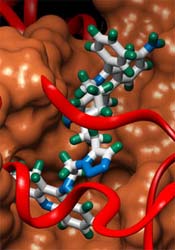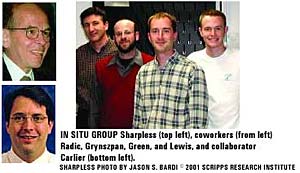An enzyme with inhibitions
 |
AChE preferentially assembles one pair of reactants into a triazole adduct. Credit: Flavio Grynszpan, TSRI.
|
|
Many drugs target enzymes and protein receptors, slotting into their active sites and either triggering activity or shutting them down. Drug designers would like a fast and efficient way to come up with novel inhibitors for specific enzymes and receptors but even with computers that let them do the research in silico and combinatorial methods that create thousands of possibilities in one go, they still don't always get the hit they want.
Barry Sharpless and his team at the Scripps Research Institute in California have enlisted the help of the target enzyme itself to help seal its own doom. They chose the well-studied enzyme acetylcholine esterase (AChE), which plays an extremely important role in the transmission of nerve signals and for which reversible inhibitors are already used in the treatment of some symptoms of Alzheimer's disease as well as myasthemia gravis.
The team started with pairs of complementary building blocks that would bind to each of AChE's binding positions in its active site. If both building blocks of their test molecules did bind to both sites the building blocks themselves would then be close enough so that their "chemical complementarity" would make them react with each other. A chemical reaction therefore reveals which pair of building blocks has bonded to the enzyme.
| |
 |
| Barry Sharpless |
Under normal circumstances, with the selected click chemistry components randomly circulating in a reaction vessel, it takes years to line up properly for this click reaction to take place. However, when the target enzyme was introduced into the picture, contiguous binding sites on the enzyme's surface acted like hands that grabbed and oriented the click components, snapping them together.
The secret to success in this method is the right choice of coupling groups. They must not be so reactive that they couple with each other at room temperature without the enzyme. They must also not attack the enzyme. The researchers found a solution that is not seen every day. The reactive group of the first building block is a linear arrangement of three nitrogen atoms (azide), which is attached to a carbon atom. The second building block contains a triple bond between two carbon atoms (acetylene). When these two groups are optimally stretched out next to each other, their bonds "flip" around in a cycloaddition reaction to form a five-membered ring, which fuses the two building blocks together.
 |
Sharpless top left, Radic, Grynszpan, Green and Lewis, Carlier bottom left.
|
Of the 98 possible building-block combinations (two regioisomers per untemplated reaction) they tested only one was a "hit". But it turns out to be the strongest reversible AChE inhibitor known! "This is the fruit of an archetypal multidisciplinary endeavor including molecular modelling for the design of the building blocks, organic synthesis in the preparation of these components, specialized spectroscopic analytical tools to identify the produced inhibitors, and enzymology to determine their inhibitory power," explains team member Flavio Grynszpan. "This combination of expertise together with the right ligation chemistry makes this approach not only powerful but also practical," he adds.
Even with modern methods, the search for new pharmaceutical agents is a laborious affair. Getting enzymes and receptors to cooperate actively in the search for their own inhibitors could be the next step in drug design. "In a sense it is like establishing a direct dialogue between the enzyme and the chemist," expands Grynszpan, "Obviously, any whisper of information coming from the mouth of the protein is very significant."
Angew. Chem. Int. Ed. 2001, 41 (6), 1053.

